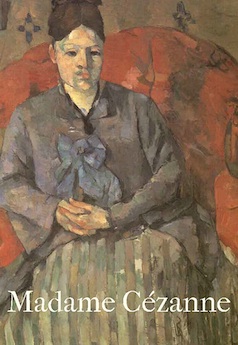By Svetlana Alpers
This book is the record that remains of a marvelous exhibition at the Lehman Collection of the Metropolitan Museum. It was extraordinary to be able to spend time there looking at the array of drawings and painted portraits that Cézanne made of his wife Hortense Fiquet over about the twenty year period from 1872 to 1892. He painted her more often than any other subject except himself.
She, the marriage, and the portraits have had a bad press: she, because of her apparent lack of interest, dismissal even of her husband’s art and having instead a taste for clothes; the marriage, because Cézanne and she lived mostly apart and he kept her hidden from his father to safeguard his allowance, only marrying in order to assure his inheritance going to Paul, their son; the paintings, because they seem detached and cold.
But the exhibition and book show something different: a woman willing to pose patiently for her husband. (Vollard, his dealer, writes of posing for 115 days only to have Cézanne stop and leave Paris for Aix.) It is fascinating to repeatedly see her with reddish hair parted in the center and gathered up and back, a firm jaw, distinctive asymmetrical narrow eyes, and, as her husband so often rendered her, one prominent ear with the other most curiously left out. And, indeed her carefully chosen clothes provide elegant touches which he treated with respect. Photos of her in the book when she was old show that the look and the clothes were there for good.
Her clothes are prominent in the great depiction of her (now in Boston), immortalized by Rilke, sitting in a throne – like red chair, wearing a striped blue dress whose color is picked up in details of the wall-paper pattern behind. In a painting at the Metropolitan Museum in New York, she is seated outside in the conservatory of the Cézanne family home in Aix, her splendid dark, high-necked dress set against a tree, plants, and fruits, her head angled like the wall behind her. So taken are we by the overall look, that it is astonishing to see that the hands resting on her lap were left unfinished by the painter.
The book gives one access to two supreme works that did not make it to the exhibition. First (pl. 42), a meltingly loving graphite and watercolor drawing of Hortense’s arm and head tucked into a pillow and juxtaposed with a burst of flowers (hortensias) with prominent green leaves. And second (pl. 6), Cézanne’s painting of his wife in a grey dress in a pink armchair gripping a fan. The interest here is that it was once owned by Gertrude Stein. It is clear that Hortense’s extraordinary mask-like face was where Picasso found the solution for his portrait of Stein. Picasso, it seems, did not turn to an African mask but to Cézanne. A photograph (fig.39) shows that at one time Stein linked the two portraits on the wall of her atelier on rue Fleurus.
So far I have been treating the book as an experience in looking. It is that, and more: a pungent general introduction by Dita Amory, the organizer of the exhibition; a respectful testimony by Philippe Cézanne, a great grandchild; a close analysis of his painting manner by Charlotte Hale; a clarifying summary of the literature on Madame on Cézanne by Ann Dumas; a riveting technical examination of the drawings by Marjorie Shelley; another searing essay by Hillary Spurling here comparing Matisse and Cezanne in the portrayal of their wives. Closing, with grace, Amory and her assistant Kremnitzer consider some artistic riffs done after Cézanne’s Madame Cézannes.
This is a book to value for the looking as well as for the reading.
Svetlana Alpers, an artist, critic and renowned art historian, is professor emerita of the history of art at the University of California, Berkeley and a visiting scholar in the Department of Fine Arts at New York University.




